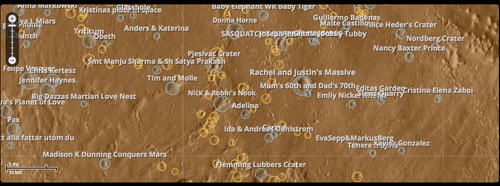
A screenshot of Uwingu’s Mars map, populated with a variety of names of craters purchased by the public.
Last week, Uwingu, a venture that last year solicited names for exoplanets, announced that it was allowing the public to name craters on Mars. Starting at just $5 (and up, depending on the size of the crater), people could pick a crater that currently has no name on Mars and name it. Uwingu plans to use those funds to support space research and education: in excess of $10 million dollars, if Uwingu gets people to pay for names for all the approximately 500,000 unnamed craters on Mars.
“We’ve had thousands of features named on Mars already,” Uwingu’s Alan Stern said in a phone interview over the weekend. “Since we’ve debuted this, we’ve named about as many features as the old system, naming through the astronomical committees, named in the previous fifteen years.”
The Uwingu website doesn’t keep a running tally of the number of names assigned to date, but does have a map that is updated in near real time that lists the craters that have been named. There’s a mix of craters named after people and those with more… whimsical names: “Daniel’s Pit of Awesome,” “Big Dazzas Martian Love Nest,” and “SASQUATCH’S SLIPPERY SINKHOLE.”
Stern said they plan to examine the choice of names people assign to craters, to look for trends. “Are people naming them after relatives primarily, famous people, historic places on Earth, sports teams, artists; what’s the distribution of naming types?” he said. “We’re interested not just in what people name things, but why they name things.”
Uwingu’s plans to name craters, though, has encountered some opposition. The International Astronomical Union (IAU), which currently handles the naming of features on Mars and other celestial bodies, told Space News last week it would not sanction any of the names chosen by participants in Uwingu’s effort. And, in a blog post yesterday, lunar scientist Paul Spudis expressed his opposition to this effort in no uncertain terms. “I find this new Uwingu scheme offensive because it preys on the ignorance and trust of the general public,” he wrote, likening Uwingu’s Mars map to the International Star Registry, a company that has sold names of stars to the public with the veneer of officialdom, even though those names are not recognized by IAU or other astronomers.
Stern, in the interview, said some people have misunderstood what Uwingu is doing. “We’re not selling anything like property rights or naming rights,” he said. “We’ve just created a Mars map that grandfathers in everything that’s already been named—about 15,000 features—and takes just the craters and asks the public, ‘What would you name these features?'”
Uwingu addresses that issue as well in a FAQ on its website. “How will our Uwingu Mars feature names be used? They’ll be used by anyone using Uwingu’s Mars maps. For now that’s just the public, but soon, we hope, scientists and space missions to Mars will be using these maps too.” In other words, that name is only as official as that map.
On Monday, one organization announced that it would use that map in its future missions. Mars One, the Dutch venture that has long-term plans to send humans to Mars on one-way missions, said its future missions, starting with a lander and orbiter slated for launch in 2018, will carry the Uwingu map, and that it will use the map as part of its mission operations. In return, Mars One will get a share of the proceeds of the Uwingu Fund; Stern said he couldn’t discuss specific numbers, but that Mars One gets a “slice of the Uwingu Fund for a limited period of time” that “leaves plenty of headroom for tons of other grants.”
“For us it’s a really nice partnership,” Mars One CEO Bas Lansdorp said in an interview Sunday on The Space Show, where the agreement between Mars One and Uwingu was first publicly announced. Including the map on Mars One’s 2018 missions is “the really nice thing Mars One can contribute to this partnership,” he added. “That name will actually travel to Mars, land on Mars on 2019… and your name will really be on Mars.”
Of course, Mars One has plenty of skeptics who wonder if the venture can raise enough money to pay for those initial robotic missions, let alone those long-term human plans. Uwingu’s Stern, though, is happy about it. “I’m really psyched about it,” he said of the partnership with Mars One, “because not only can people who put names on our map know that that’s going to the surface of Mars, but also, having an actual an actual Mars mission adopt our map as their standard for mission operations makes it a lot more interesting for people.”

Is it safe to mix up the 2 different snake oil?
I think that’s a great idea. Monopolies bite the dust. Why not let the general public make a decision on naming parts of the Solar System? After all, I think that’s called freedom of expression or some such silly idea.
On the other hand it also shows that – besides all rules and regulations – when it comes to exploration: whoever puts his boot on the ground first has probably a greater say in naming that ground as well.
One scammer meets another fellow scammer.
Mader Levap:
Do you really think all those scientist,scollars,a nobel prize winner,and big companies would want their name on the Mars One site if it was a scam? Think again…